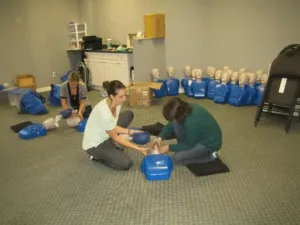VFA (Vancouver First Aid) is the leader in provider in CPR and AED courses throughout the Tri-Cities area and in Coquitlam, B.C. A variety of courses are available at the new training centre which has opened in the Summer of 2016. Free parking, plenty of amenities and close proximity to public transit make this the ideal location for candidates needing first aid, CPR, food safe, WHMIS, TDG, mask fit and more. Certification is provided upon the day of completion of any of the above mentioned courses. Some courses including, infant CPR training is available as a private in home class or on-line. Read through this page to find more information about all the courses available with VFA including the many CPR and AED courses in Coquitlam.
How to Contact VFA for Course Registration
- Website: www.vancouverfirstaid.ca
- Email: [email protected] / [email protected]
- Telephone: +1 604-260-6899
What Courses include CPR and AED Training?

The following courses include CPR and AED training:
- CPR level “A”
- CPR level “C”
- CPR level “HCP”
- Standard first aid
- Emergency first aid
- Emergency childcare first aid
- Standard childcare first aid
- Basic Life Support (Via the Heart and Stroke Foundation)
What is the difference between CPR “A”, “C” and “HCP”?
This is a common question asked amongst customer’s. CPR level “A” teaches participants about adult CPR rescues only. CPR level “C” teaches participants about rescues for victims of all ages. The CPR level “HCP” also known as CPR level “C” for health care providers teaches participants CPR rescue techniques for victims of all ages at a health care provider level. This includes using bag valve masks and trained backup.
Where do the standards for CPR come from?
Approximately every 3 to 4 years the International Liaison Committee on Resuscitation (also known as ILCOR) releases the latest statistics and standards in cardiopulmonary resuscitation and automated external defibrillator (AED) usage. This governing body, which includes stats and help from the Heart and Stroke Foundation, provide updates in CPR rescue techniques that are to be taught to lay and trained rescuers. The latest release of data comes out in 2016.
What are the latest Compression to Ventilation Ratios?
One of the most important things for rescuers to remember is the ratio of compressions to ventilations. The latest standards from ILCOR state that lay rescuers should aim to have 30 compressions per 2 breaths. Learn more about CPR and AED usage by enrolling in a CPR course in Coquitlam with VFA today.
